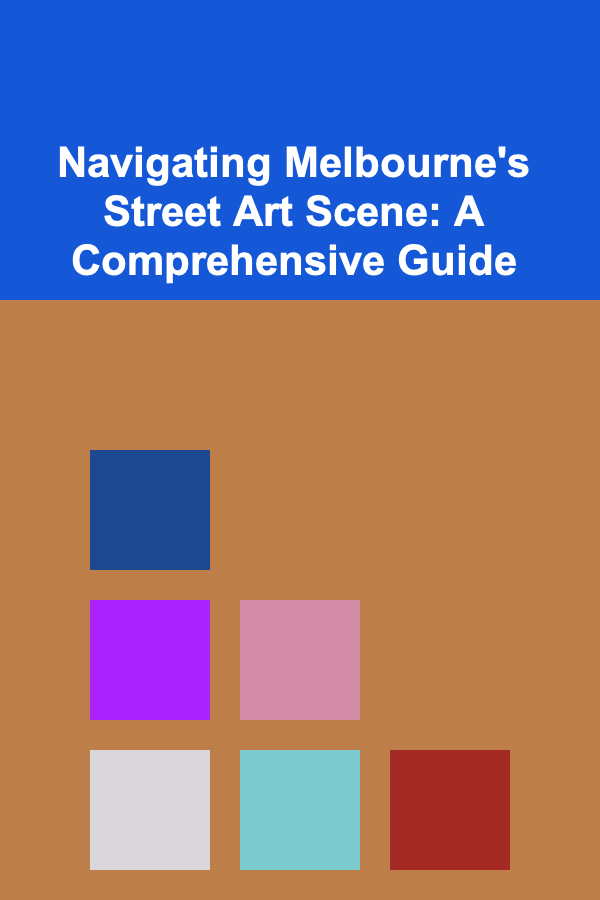
Navigating Melbourne's Street Art Scene: A Comprehensive Guide
ebook include PDF & Audio bundle (Micro Guide)
$12.99$10.99
Limited Time Offer! Order within the next:

Melbourne, Australia, is renowned as a global hub for street art. More than just graffiti, it's a vibrant and ever-evolving art form that transforms the city's laneways and building facades into an open-air gallery. Navigating this dynamic scene requires more than just wandering aimlessly; it demands an understanding of its history, its diverse styles, the ethical considerations involved, and the best ways to experience it responsibly and respectfully. This guide aims to provide a comprehensive overview, equipping you with the knowledge and insights to fully appreciate Melbourne's unique street art landscape.
Understanding the Roots and Evolution
Melbourne's street art scene didn't appear overnight. It's a product of decades of artistic expression, social commentary, and urban development. Understanding its historical context is crucial for appreciating its current form.
The Early Days: Graffiti and Tagging
Like many cities around the world, Melbourne's initial foray into street art began with graffiti and tagging. In the late 1970s and early 1980s, inspired by the New York graffiti scene, local artists began experimenting with tagging and simple throw-ups on trains and walls. This initial phase was often associated with rebellion and counter-culture, and it faced significant opposition from authorities.
The Rise of Stencil Art
The mid-1990s saw a significant shift with the emergence of stencil art. Stencil art offered a more controlled and accessible way to create intricate and detailed images, often carrying political or social messages. Pioneering artists like Meek (real name: Meek One), known for his intricate stencils and thought-provoking imagery, played a key role in legitimizing street art as a form of artistic expression. Stencil art also allowed for faster and more efficient creation, making it easier for artists to leave their mark on the urban landscape.
The Impact of International Artists
Melbourne's street art scene has always been influenced by international artists. Over the years, numerous renowned artists from around the world have visited Melbourne, leaving their own murals and contributing to the city's diverse artistic landscape. These collaborations and exchanges have helped to push the boundaries of street art and introduce new styles and techniques to the local scene.
From Illegal Art to Commissioned Murals
A significant turning point in Melbourne's street art history was the gradual acceptance and even embrace of street art by local authorities and businesses. While illegal tagging and vandalism still exist, many businesses now commission artists to create murals on their buildings, recognizing the artistic and economic value of street art. This shift has led to a more diverse and sophisticated street art scene, with a wider range of styles and themes represented.
Key Styles and Techniques
Melbourne's street art scene is characterized by its diversity of styles and techniques. From traditional graffiti to intricate stencils and large-scale murals, there's something to appeal to every artistic taste. Understanding the different styles will help you appreciate the artistry and skill involved in creating these works.
Graffiti and Tagging
While often considered the most basic form of street art, graffiti and tagging are still an integral part of the scene. Tagging involves writing one's name or signature in a stylized manner, while graffiti encompasses a wider range of lettering styles and techniques. While much tagging is considered vandalism, skilled graffiti artists can create impressive and complex works of art.
Stencil Art
Stencil art involves cutting out designs from a sheet of material (typically cardboard or acetate) and then applying paint through the cut-out areas. This technique allows for the creation of precise and repeatable images, making it ideal for political or social commentary. Stencil art can range from simple single-layer designs to complex multi-layered creations.
Paste-Ups
Paste-ups involve creating artwork on paper or other materials and then adhering them to walls or other surfaces using glue or wheat paste. This technique allows artists to create intricate and detailed works in their studios and then quickly install them in public spaces. Paste-ups are often used for political posters, street advertising, and artistic installations.
Murals
Murals are large-scale paintings on walls or other surfaces. They can be created using a variety of techniques, including spray paint, brushwork, and even mosaics. Murals are often commissioned by businesses or organizations to add color and vibrancy to their buildings or to convey a specific message. Some murals are incredibly detailed and take weeks, even months to complete.
Yarn Bombing
A more recent addition to the street art scene, yarn bombing involves covering objects in public spaces with knitted or crocheted yarn. This technique adds a touch of whimsy and color to the urban landscape and can be used to highlight forgotten or neglected objects.
3D Street Art (Anamorphic Art)
This involves creating artwork that appears three-dimensional when viewed from a specific angle. This requires meticulous planning and execution to create the illusion of depth and perspective on a flat surface. Melbourne has seen some excellent examples of this style, particularly at festivals and events.
Iconic Locations for Street Art in Melbourne
While street art can be found throughout Melbourne, certain laneways and areas are particularly known for their vibrant and ever-changing displays. Knowing these key locations will help you maximize your street art experience.
Hosier Lane
Hosier Lane is arguably Melbourne's most famous street art laneway. Located in the heart of the city, it's a constantly evolving canvas featuring a diverse range of styles and techniques. From graffiti and stencil art to paste-ups and murals, Hosier Lane offers a glimpse into the heart of Melbourne's street art scene. Be prepared for crowds, especially during peak tourist season.
AC/DC Lane
Named after the iconic Australian rock band, AC/DC Lane is a gritty and vibrant laneway known for its rock-themed street art. Located near the city's entertainment precinct, it's a popular spot for music lovers and art enthusiasts alike.
Union Lane
Another popular street art laneway in the city center, Union Lane features a mix of styles and techniques. It's a great place to discover emerging artists and to see the latest trends in street art.
Fitzroy and Collingwood
Located just north of the city center, the inner-city suburbs of Fitzroy and Collingwood are known for their alternative culture and thriving street art scene. Wander through the backstreets and you'll discover a wealth of hidden gems, from small-scale paste-ups to large-scale murals. Johnston Street in Fitzroy is particularly noteworthy.
Brunswick
Further north, Brunswick offers a more raw and less touristy street art experience. Sydney Road, in particular, is home to some impressive murals and graffiti art, often with a focus on political and social issues.
Footscray
Located in Melbourne's west, Footscray is a culturally diverse suburb with a growing street art scene. Its murals often reflect the area's multicultural heritage and social issues.
Ethical Considerations and Responsible Viewing
While street art is a vibrant and exciting art form, it's important to view it responsibly and ethically. Respect for the artists, the property owners, and the community is crucial.
Respecting Artists' Rights
Street art, even when created illegally, is still a form of artistic expression. It's important to respect the artists' rights by not defacing or damaging their work. Do not add your own tags or graffiti to existing artworks.
Understanding the Legality
While Melbourne has a relatively tolerant attitude towards street art, it's important to remember that much of it is technically illegal. Creating street art without permission is considered vandalism and can result in fines or even arrest. Be aware of the legal implications before creating your own street art.
Asking for Permission
If you're interested in creating your own street art, always seek permission from the property owner first. Many businesses are happy to commission artists to create murals on their buildings, but it's essential to get their consent beforehand.
Supporting Local Artists
Support the local street art scene by purchasing artwork from local artists, attending exhibitions, and following them on social media. This helps to encourage and sustain the art form.
Being Mindful of Residents and Businesses
Remember that street art is often located in residential areas or near businesses. Be mindful of noise levels, especially at night, and avoid blocking access to buildings or disrupting business operations.
Leave No Trace
When visiting street art locations, be sure to leave no trace. Do not litter, damage property, or disturb the environment.
Finding Street Art Tours and Resources
If you're looking for a more structured and informative way to experience Melbourne's street art scene, consider joining a guided tour or utilizing online resources.
Guided Street Art Tours
Several companies offer guided street art tours in Melbourne. These tours are led by knowledgeable guides who can provide insights into the history, styles, and artists behind the artworks. They often provide access to hidden laneways and areas that you might not discover on your own. Research tour companies and read reviews to find one that suits your interests and budget. Some tours focus on specific styles or areas, while others offer a more general overview.
Online Maps and Resources
Numerous websites and online maps document Melbourne's street art scene. These resources can help you plan your own self-guided tours and discover hidden gems. Look for websites that feature artist profiles, location maps, and updated information on new artworks. Social media platforms like Instagram are also great resources for finding street art locations and discovering new artists.
Street Art Festivals and Events
Melbourne hosts several street art festivals and events throughout the year. These events often feature live painting demonstrations, artist talks, and opportunities to meet and interact with local artists. Check local event listings for upcoming festivals and events.
The Future of Street Art in Melbourne
Melbourne's street art scene is constantly evolving. New artists are emerging, new styles are being developed, and new locations are being transformed. Understanding the trends and challenges facing the scene can provide a glimpse into its future.
The Rise of Digital Street Art
With the advent of new technologies, digital street art is becoming increasingly popular. This involves using projectors, LEDs, and other digital devices to create interactive and dynamic artworks in public spaces. Digital street art offers new possibilities for artistic expression and can engage audiences in innovative ways.
The Challenge of Gentrification
As Melbourne continues to grow and develop, the city's street art scene faces the challenge of gentrification. Rising property prices and increased development can lead to the displacement of artists and the demolition of buildings featuring street art. Preserving the city's street art heritage requires careful planning and collaboration between artists, developers, and local authorities.
Sustainability and Environmental Awareness
Increasingly, street artists are incorporating sustainable practices and environmental themes into their work. This includes using recycled materials, creating artworks that promote environmental awareness, and advocating for sustainable urban development.
Community Engagement
The future of street art in Melbourne depends on fostering community engagement and support. This involves encouraging residents to appreciate and value street art, providing opportunities for artists to collaborate with communities, and promoting street art as a tool for social and cultural development.
Capturing the Moment: Photography and Street Art
Photographing street art is a fantastic way to document your experience and share it with others. However, there are a few considerations to keep in mind to capture the best shots and avoid causing disruption.
Respecting the Art and the Artists
While taking photos is generally acceptable, avoid touching or interacting with the artwork in a way that could damage it. Be mindful of your angles and avoid blocking the view for others who are also trying to appreciate the art.
Lighting and Composition
The best time to photograph street art is during the "golden hour" -- the hour after sunrise and the hour before sunset. The soft, warm light will enhance the colors and textures of the artwork. Consider the composition of your shots, using leading lines, framing, and the rule of thirds to create visually appealing images.
Permission and Commercial Use
While personal photography is usually fine, using photos of street art for commercial purposes (e.g., selling prints, using them in advertising) may require permission from the artist. It's always a good idea to research the artist's rights and seek their consent if you intend to use their work commercially.
Sharing Your Experience
Share your photos on social media using relevant hashtags like #melbournestreetart, #streetartmelbourne, #hosierlane, etc. Tag the artist if you know their Instagram handle. This helps to promote their work and the Melbourne street art scene in general.
Specific Artist Shout-Outs (Examples - This list can be much longer)
While Melbourne boasts a plethora of talented street artists, here are a few examples (to encourage further research and discovery):
- Adnate: Known for his stunning portraits of Indigenous Australians and people from marginalized communities. His large-scale murals are incredibly powerful and emotive.
- Rone: Renowned for his hauntingly beautiful portraits of women, often placed in abandoned or decaying buildings. His work explores themes of beauty, decay, and memory.
- Dvate: A master of aerosol art, Dvate creates incredibly realistic and detailed murals of birds and other animals.
- Heesco Khosnaran: Famous for his murals depicting Mongolian culture and history. His work is vibrant, colorful, and full of symbolism.
- Smug: A Scottish artist who has made a significant contribution to Melbourne's street art scene. Known for his incredibly detailed and realistic murals, often depicting portraits or scenes from everyday life.
This is just a small selection, and there are countless other talented artists waiting to be discovered.
Conclusion: Embracing the Ephemeral
Melbourne's street art scene is a constantly evolving and dynamic reflection of the city's culture, politics, and artistic spirit. It's a living, breathing gallery that offers a unique and immersive experience for visitors and locals alike. By understanding its history, respecting its artists, and engaging with it responsibly, you can fully appreciate the beauty and complexity of this remarkable art form. Remember that street art is often ephemeral; pieces may be painted over or removed, adding to the scene's unique and constantly changing nature. Embrace the transient nature of the art, and enjoy the moment.
So, grab your camera, put on your walking shoes, and prepare to be amazed by the vibrant and ever-changing street art of Melbourne! Happy exploring!
Reading More From Our Other Websites
- [Home Soundproofing 101] How to Soundproof Your Home from Footsteps and Stomps
- [Home Lighting 101] How to Plan Lighting for Your Home Renovation Project
- [Skydiving Tip 101] Best Pre‑Jump Stretch Routines to Prevent Twisting Injuries During Freefall
- [Sewing Tip 101] How to Combine Traditional Hand‑Stitching with Modern Machine Embroidery for Artful Garments
- [Home Staging 101] How to Stage Your Home with Green and Sustainable Elements
- [Home Soundproofing 101] How to Soundproof a Home with DIY Acoustic Panels
- [Personal Finance Management 101] How to Make the Most of Tax Deductions and Credits
- [Soap Making Tip 101] The Evolution of Soap-Making Literature: Trends, Techniques, and Future Directions
- [Tiny Home Living Tip 101] How to Create a Fully Functional Home Office in a Tiny House Without Sacrificing Living Space
- [Organization Tip 101] How to Embrace Minimalism During the Holidays

How to Develop a Yoga Sequence for Energy
Read More
How to Rent Out Your Property on Short-Term Platforms like Airbnb
Read More
How to Track Your Investments and Monitor Performance
Read More
How To Take Incredible Black Background Photos
Read More
How to Build a Thriving Online Fitness Community
Read More
How to Become a Specialized Fitness Trainer for Prenatal Women
Read MoreOther Products

How to Develop a Yoga Sequence for Energy
Read More
How to Rent Out Your Property on Short-Term Platforms like Airbnb
Read More
How to Track Your Investments and Monitor Performance
Read More
How To Take Incredible Black Background Photos
Read More
How to Build a Thriving Online Fitness Community
Read More